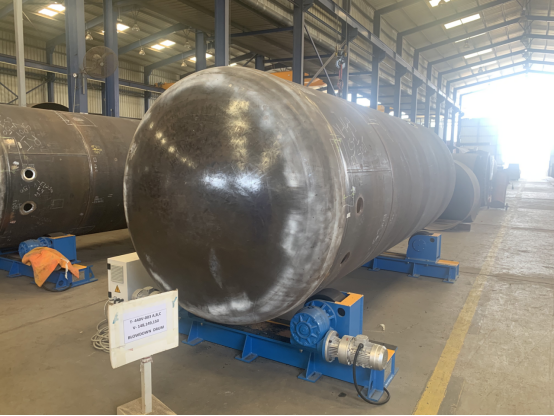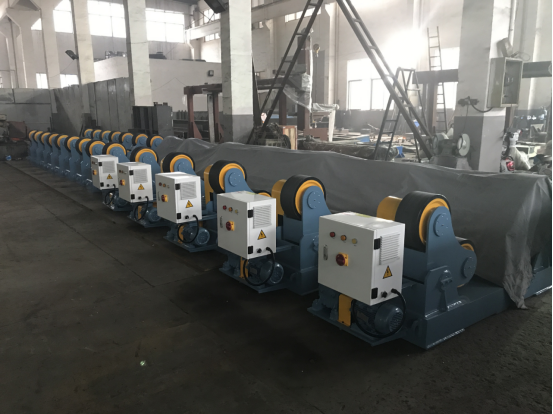In modern pressure vessel manufacturing, welding quality directly determines the safety performance and service life of equipment. As vessel sizes continue to increase and material thickness grows, traditional welding methods face challenges such as difficulty in controlling ovality and unstable weld quality. The emergence of 10-ton CNC welding rotators has brought revolutionary solutions to this industry.
Heavy-duty welding rotators[2] , with their unique rotating positioning capabilities, perfectly adapt to the welding requirements of cylindrical workpieces with different diameters. Equipped with PLC control systems and variable frequency drive technology, these devices enable precise speed adjustment (0.1-1.2 rpm) and position control, ensuring stable rotation of workpieces during welding. This automated welding positioning system not only significantly improves production efficiency but also maintains welding accuracy at industry-leading levels.

Core Technical Advantages of Welding Rotators
1. Intelligent Control Systems Enhance Welding Precision
CNC welding rotators utilize advanced digital control systems capable of storing up to 100 sets of welding program parameters. Operators simply select preset programs via the human-machine interface, and the equipment automatically adjusts key parameters such as rotator speed and tilting angle. This PLC-controlled rotator is particularly suitable for batch production, ensuring highly consistent welding quality for each product.
Compared to traditional manual welding turntables , CNC welding rotators achieve repeat positioning accuracy of ±0.1°, fully meeting the high standards for circumferential welding in pressure vessels. Additionally, the wireless remote control function allows operators to adjust welding positions from a safe distance, greatly enhancing operational safety.
2. Heavy-Duty Design Meets Industrial Requirements
To meet the special demands of pressure vessel manufacturing, 10-ton heavy-duty welding rotators adopt reinforced steel structure designs. Their rotator roller assemblies undergo specialized heat treatment processes, providing excellent wear resistance and anti-deformation capabilities. With a maximum load capacity of 10 tons, these rotators fully satisfy the welding needs of large pressure vessels.
Welding rotator manufacturers prioritize stability in their designs, employing variable frequency motor drive systems to ensure smooth and adjustable rotation speeds. Even under full-load conditions, the equipment maintains low-noise operation (<65 dB), creating a favorable working environment for operators.
Applications of Welding Rotators in Typical Pressure Vessel Manufacturing
In the production of LNG storage tanks, stainless steel welding rotators play a critical role. By precisely controlling rotator rotation speeds, these devices coordinate with automatic welders to complete circumferential welds on 9% Ni steel. This material maintains excellent toughness at cryogenic temperatures (-162°C) but imposes stringent requirements on welding processes.
Tilting welding rotators also excel in boiler manufacturing. Capable of positioning workpieces at any angle between 0-90°, these devices facilitate welding operations in various positions. Compared to conventional fixed welding turntables , this multi-functional welding positioning system significantly improves welding efficiency and quality.

Future Development Trends and Technological Innovations
With the continuous advancement of smart manufacturing technologies, automated welding positioning systems are evolving toward greater intelligence and efficiency. New-generation equipment will integrate machine vision systems and AI algorithms to enable real-time monitoring of weld quality and automatic optimization of process parameters.
Intelligent anti-collision rotators will become mainstream, using laser ranging and pressure-sensing technologies to automatically adjust workpiece positions and avoid collision risks during welding. Meanwhile, the incorporation of cloud-based data management functions will make equipment maintenance and process optimization more convenient and efficient.
Conclusion
The 10-ton CNC welding rotator, with its advantages of high-precision positioning, heavy-load capacity, and intelligent control, is reshaping the process standards for pressure vessel manufacturing. Whether for large storage tanks or high-pressure vessels, this industrial-grade welding positioning equipment provides reliable solutions, helping enterprises enhance product quality and production efficiency.
